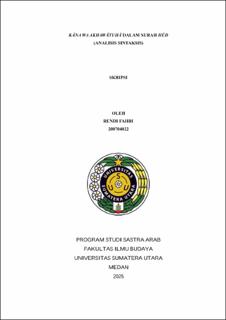Kāna Wa Akhawātuhā dalam Surah Hūd (Analisis Sintaksis)
Kāna Wa Akhawātuhā in Surah Hūd (Syntactic Analysis)

Date
2025Author
Fahri, Rendi
Advisor(s)
Kacar, Ginting
Suri, Nursukma
Metadata
Show full item recordAbstract
This study examines about kāna wa akhawātuhā in surah Hūd (Syntactic Analysis). The are threefold of this researches: to reveal taṣrif, ism and khabar as well as the meaning of kāna wa akhawātuhā in surah Hūd. This research uses descriptive qualitative methods, data collection techniques using listening and nooting. The theories used in this research are nahwu theory proposed by Ni’mah's about tasrif, ism and khabar kāna wa akhawātuhā, while nahwu theory proposed by Hamid's about meaning of kāna wa akhawātuhā and web interpretation to reinforce the meaning. The results show that there are 41 kāna wa akhawātuhā in surah Hūd. The forms of tasrif kana found are fi’l madi and fi’l mudari’ while fi’l amar is not found. There are 29 kāna, 7 laisa, 2 aṣbaḥa, 1 mā zāla, and 2 mā dāma that have no ism because they are fi’l maḍi tam. The khabar kāna wa akhawātuhā consists of 9 khabar mufrad, 17 khabar syibhu jumlah, 13 khabar jumlah fi’liyah while there is no jumlah ismiyah, and 2 that do not have khabar because they are fi’l maḍi tam. The meanings of kāna which are al-inqiṭāʻu are 28 and al-istimrāru are 1. The siblings of kāna which are aṣbaḥa which means ‘in the morning’ are 2, laisa which means ‘not’ are 7, mā dāma which means ‘during’ are 2, and mā zāla which means ‘always’ are 1.
Collections
- Undergraduate Theses [415]
